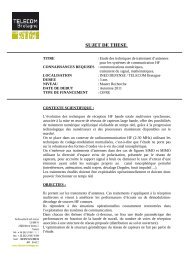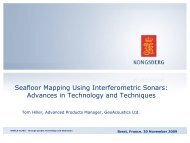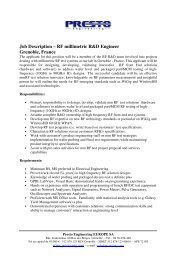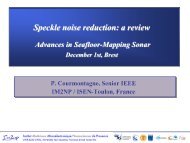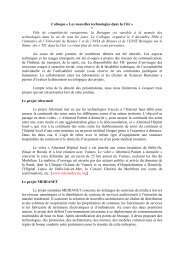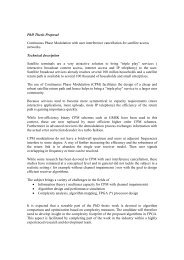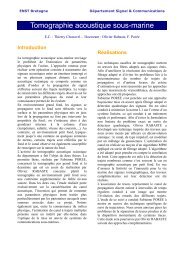Département Réseau, Sécurité et Multimédia Rapport d'Activités 2008
Département Réseau, Sécurité et Multimédia Rapport d'Activités 2008
Département Réseau, Sécurité et Multimédia Rapport d'Activités 2008
Create successful ePaper yourself
Turn your PDF publications into a flip-book with our unique Google optimized e-Paper software.
inside the corresponding d<strong>et</strong>ection rulesignature managed by some IntrusionD<strong>et</strong>ection System. We should note here thatthe reaction must be consistent with theminimal security policy. As a matter of fact, if aservice should be active for any circumstanc<strong>et</strong>hen a reaction, which consists in stopping thisservice, should not be launched.The intermediate level of reaction is based ona diagnosis of the intrusion process (forinstance provided by CRIM) and used toimprove the reaction process. Activating anautomatic or a manual response depends onthe confidence level of the diagnosis and theautomatic choice may be performed bymeasuring the impact of the correspondingreaction. At the intermediate level, anticorrelation[10] may be used as a way to findautomatically a s<strong>et</strong> of reactions in order to stopa global attack scenario. Some correlation andfusion tools, implemented during the lastdecade, provide a s<strong>et</strong> of counter measures thatmay be either activated automatically or l<strong>et</strong> theadministrator choose the appropriate ones forsecurity agility considerations.Finally, the global level reaction aims todynamivally trigger new rules of the securitypolicy according to the current threat. For thisgoal, contexts are used for renewing thesecurity policy according to the d<strong>et</strong>ectedthreat. Three steps are performed at this level;activating contexts, triggering generic policyrules accordingly and producing a coherent s<strong>et</strong>of rules to deploy while ensuring conflictresolution with the minimal securityrequirements. As a result of this level, a newpolicy security is redeployed as long as th<strong>et</strong>hreat or its consequences remain present. Ar<strong>et</strong>urn to a non threat situation is thenperformed by the threat context deactivationoperation.ConclusionIn this work, we aim at connecting monitoringsystems (intrusion d<strong>et</strong>ection) with securitypolicies in order to provide response to threat.The OrBAC formalism is used to accomplishthis task. A prototype of the threat responsesystem is developed [2] to dynamicallyactivate security rules in response to alertsthanks to a mapping strategy which providesmeans not only to react specifically to aconsidered intrusion, but also to goballyprotect other threatened entities of theinformation system.References[1] H. Debar, Y. Thomas, N. Boulahia-Cuppens, F. Cuppens. Using contextualsecurity policies for threat response . ThirdInternational Conference on D<strong>et</strong>ection ofIntrusions & Malware, and VulnerabilityAssessment (DIMVA). Berlin, Germany. Juill<strong>et</strong>2006.[2] H. Debar, Y. Thomas, N. Boulahia-Cuppens, F. Cuppens. Threat response throughthe use of a dynamic security policy. Journal ofComputer Virology, Springer, 2007.44 Extract of Pracom’s Annual Report <strong>2008</strong>




